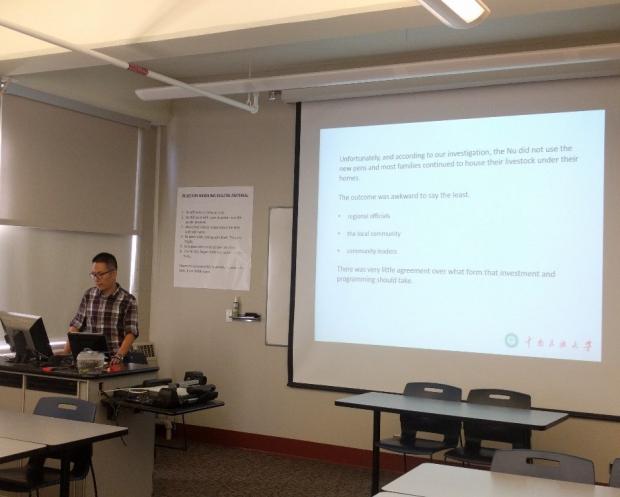“Living with Livestock: Development Models in China” and Why Cultural Context Matters

On September, 14, Shengyu Pei, an associate professor at the South-Central University for Nationalities in Wuhan, China, gave a talk at the Department of Anthropology. Dr. Pei discussed findings from his ethnographic research among ethnic minority groups in the south-west of China and addressed policy implications of his research. Shengyu Pei started his talk by providing the context for China’s economic development. State actors and the public, he explained, viewed rapid growth and development of urban spaces as symbols of the great achievements of China’s reforms over the past 40 years. Recognizing the importance of urbanization, the government also sought to address pressing social issues, particularly acute in the rural areas. In 2014, government-sponsored the Targeted Poverty Alleviation (TPA) program was launched to address and end rural poverty in China. The TPA policies focused on multiple aspects of development, including education, expansion of social security, and modern housing. Shengyu Pei’ research sought to address the policy implementation gap between the cultural context of the housing traditions, local communities’ needs, and TPA’s goals.

Dr. Pei conducted research among the Nu people in Yunnan province of China. The Nu are an ethnic minority group living in along the Nu river valley and among the mountains near the China – Myanmar border. This region has a high poverty rate and local populations lack modern infrastructure and amenities. In his research, Shengyu Pei investigated the cultural and economic values behind the “living with livestock” practice. The Nu people used to construct pens for their domestic animals (primarily, pigs) on the ground floor of their houses, either under the bedroom or under the kitchen or storage spaces. While culturally embedded practice related to self-sustenance of the households, the government viewed “living with livestock” as a sign of extreme poverty that should be ended. Aiming to eliminate the practice, the state constructed new pens for the Nu to keep their animals apart from the house. However, Shengyu Pei’s research showed that the Nu people did not use the new pens and were frustrated by the changes. Although the Nu recognized that keeping the animals separately from the house can be healthier, it was more convenient and cheaper to keep the animals in the in-house pens. Pei’s findings pointed at a little the tensions that exists between local practices and the government’s investments.
Pei’ research brought policy implementation closer to understanding the community’s needs. While discussing his findings, Shengyu Pei noted that local populations and their cultural practices were often assumed to be a ‘problem” for the state. In fact, the state would often blame local groups like the Nu for their poverty. Pei developed community-engaged ethnographic research as a means to break out of the blaming cycle and to empower the local people as they voiced their cultural values, needs, and concerns. Shengyu Pei argued that the local people must be part of the solution and for an anthropology that defines local people as decision-makers. Shengyu Pei concluded that these efforts will allow for sustainable development and better outcomes of the Targeted Poverty Alleviation program in China.
